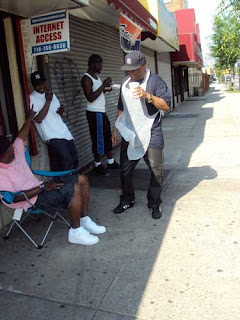In the Spirit of a Queens Queen-Doris Ward
story and photos by Jocelyn M.Goode
Melodic jazz tunes rolled through the evening summer air as a Jazzmobile band warmed up for their set. The quartet included a congo drummer, an electric guitarist, a keyboardist, and Lonnie Youngblood, the lead singer. Jazzmobile is a traveling jazz festival that celebrates acclaimed artists from the U.S. and abroad who are regular performers by bringing live, free concerts to neighborhoods in Harlem, New York. For the sixteenth year in a row however, Jazzmobile musicians arrived on 198th St. in Hollis, one of only two Queens neighborhoods that the Harlem festival reaches. How did this quiet block become the recipient of such an annual special performance? The answer lies in the enduring effort and spirit of Doris Ward.
The late, great Lady D. as her friends lovingly donned her was known as a generous entertainer, fierce fashionista and avid lover of jazz. After retiring from serving as a nurse on Riker's Island Correctional Facility, Doris ran a home-based fashion business and hosted spectacular shows regularly. Even though she resided on 198th St in Hollis, Queens, she traveled visited often her hometown of Harlem to hear the latest from the most popular jazz artists of the moment. Her passion for culture and bringing people together led Mrs. Ward to coordinate with the 198th St. Block Association. Almost two decades ago she was able to influence them to use their entertainment budget to support Jazzmobile and to bring live, jazz concerts to her street. They have been doing so ever since.
 198th St. in Hollis, Queens
198th St. in Hollis, QueensLady D's reputation as a woman who made big things happen was echoed by those who knew her closely. Her popularity had the streets filled every year with friends, families and community members who knew that the Jazzmobile concerts also sparked BBQs, kids playing and the inter-generational socializing. While this year's concert was the first without Doris Ward as she transitioned in March 2009, her spirit lives on in the people she touched. Her closest acquaintances had this to say about her:
"She was a lady of elegance. If you knew her, you could love her...She was a woman to be reckoned with."-Margie Ginn
"She had a good heart. She would tell you like it is...she was very frank. She was a short little lady and she dressed like a royal queen."-Jean Nichols
"She was a joy...She's from the jazz era, that's why she loves Jazzmobile."-Gloria Butcher
"She was a person that didn't want to see anyone without. She would do what it takes so you could have what you need. She was a beautiful person."-Jacquie Rucker



Doris Ward expertly practiced what FAIM Internet Magazine stands upon--utilizing common culture to connect communities. Jazzmobile's latest concert on 198th St. was beautiful as whole families from grandparents to toddlers bobbed their heads to classic jazz tunes. The lead singer and saxophonist, Lonnie Youngblood even convinced several seniors and teenagers to form a chorus line, doing Rockette kicks to his rendition of "New York, New York".





The legacy that Lady D. created by instituting such a unifying tradition will continue to endure. The next generation is now taking on the responsibility to ensure that Jazzmobile keeps returning to 198th St. in Hollis, Queens. To learn more about Jazzmobile visit their website at www.jazzmobile.org















































